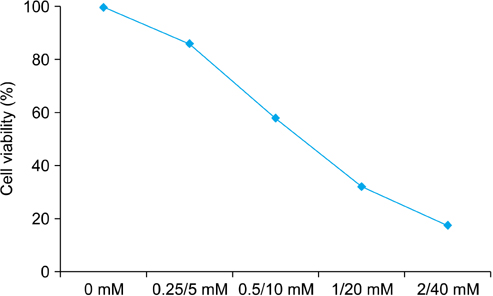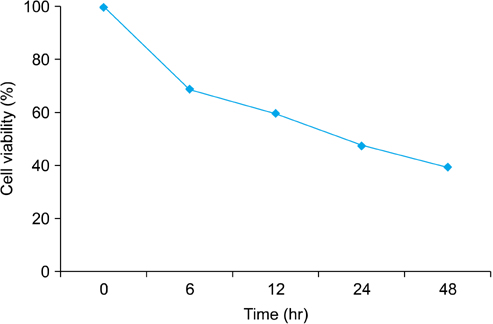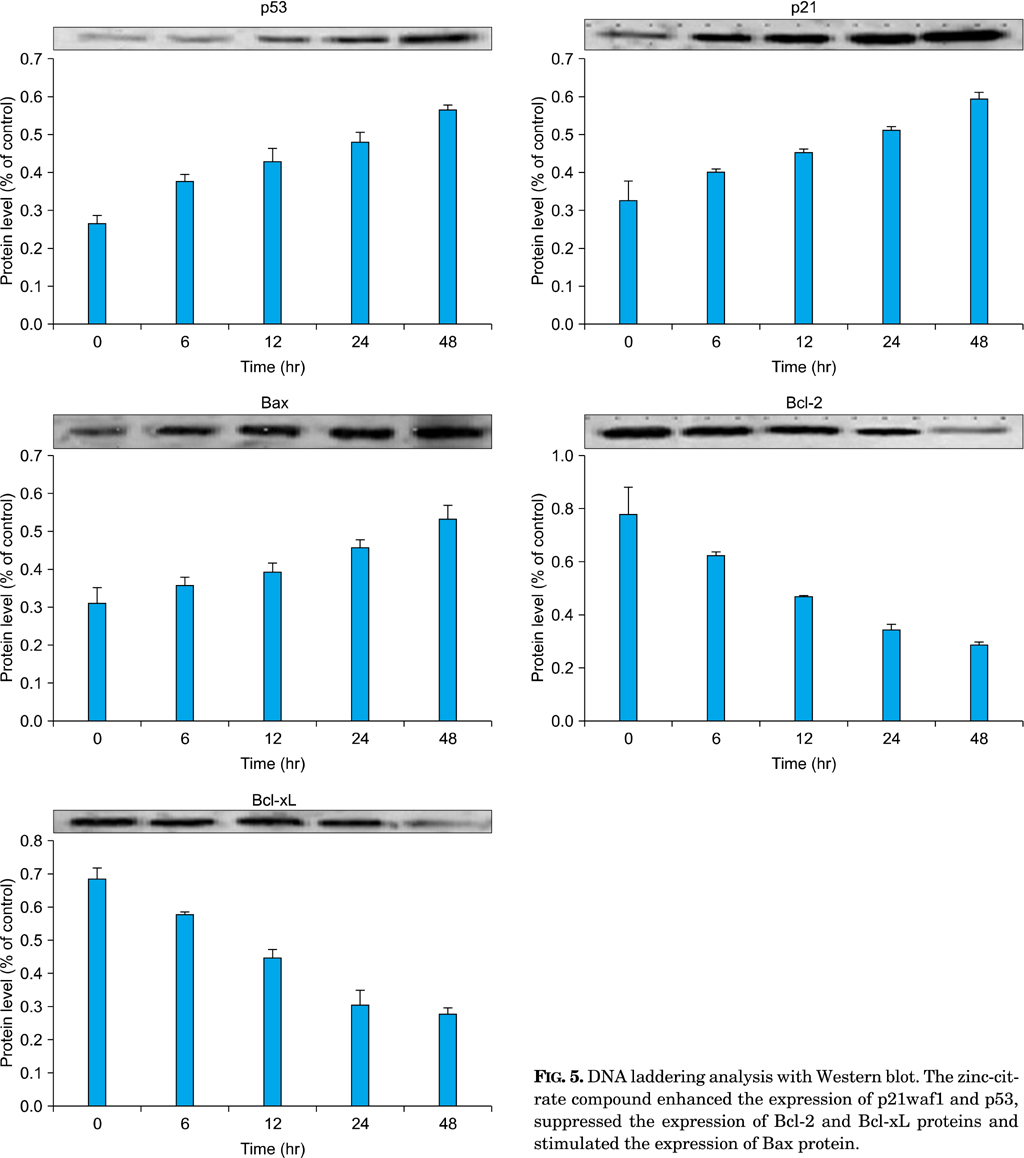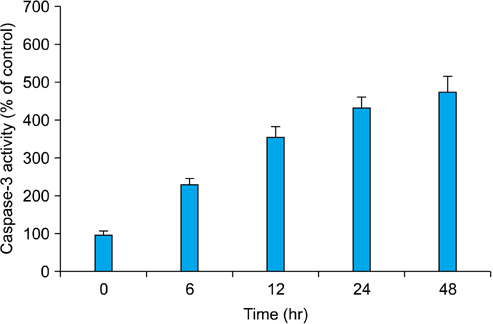Korean J Urol.
2012 Nov;53(11):800-806.
Induction of Apoptosis of Bladder Cancer Cells by Zinc-Citrate Compound
- Affiliations
-
- 1Department of Urology, The Catholic University of Korea College of Medicine, Seoul, Korea. ksw1227@catholic.ac.kr
Abstract
- PURPOSE
Zinc is one of the trace minerals in the body and is known to have an anticancer effect by inducing apoptosis in prostate cancer. We aimed to investigate the antiproliferative effects of a zinc-citrate compound in bladder cancer.
MATERIALS AND METHODS
A bladder cancer cell line (MBT-2) was treated with a zinc-citrate compound at different time intervals and concentrations. Mitochondrial (m)-aconitase activity was determined by use of the aconitase assay. DNA laddering analysis was performed to investigate apoptosis of MBT-2 cells. The molecular mechanism of apoptosis was investigated by Western blot analysis of p53, p21waf1, Bcl-2, Bcl-xL, and Bax and also by caspase-3 activity analysis.
RESULTS
Treatment with the zinc-citrate compound resulted in a time- and dose-dependent decrease in cell number of MBT-2 cells. M-aconitase activity was significantly decreased. DNA laddering analysis indicated apoptosis of MBT-2 cells. The zinc-citrate compound increased the expression of p21waf1 and p53 and reduced the expression of Bcl-2 and Bcl-xL proteins but induced expression of Bax protein. The zinc-citrate compound induced apoptosis of MBT-2 cells by activation of the caspase-3 pathway.
CONCLUSIONS
We have shown that a zinc-citrate compound induces apoptotic cell death in a bladder cancer cell line, MBT-2, by caspase-3 activation through up-regulation of apoptotic proteins and down-regulation of antiapoptotic proteins.
Keyword
MeSH Terms
-
Aconitate Hydratase
Apoptosis
bcl-2-Associated X Protein
bcl-X Protein
Blotting, Western
Caspase 3
Cell Count
Cell Death
Cell Line
DNA
Down-Regulation
Minerals
Prostatic Neoplasms
Proteins
Up-Regulation
Urinary Bladder
Urinary Bladder Neoplasms
Zinc
Aconitate Hydratase
Caspase 3
DNA
Minerals
Proteins
Zinc
bcl-2-Associated X Protein
bcl-X Protein
Figure
Reference
-
1. Ferlay J, Shin HR, Bray F, Forman D, Mathers C, Parkin DM. Estimates of worldwide burden of cancer in 2008: GLOBOCAN 2008. Int J Cancer. 2010. 127:2893–2917.2. Heney NM. Natural history of superficial bladder cancer. Prognostic features and long-term disease course. Urol Clin North Am. 1992. 19:429–433.3. Lutzeyer W, Rubben H, Dahm H. Prognostic parameters in superficial bladder cancer: an analysis of 315 cases. J Urol. 1982. 127:250–252.4. Powell SR. The antioxidant properties of zinc. J Nutr. 2000. 130:5S Suppl. 1447S–1454S.5. Truong-Tran AQ, Carter J, Ruffin RE, Zalewski PD. The role of zinc in caspase activation and apoptotic cell death. Biometals. 2001. 14:315–330.6. Bae SN, Lee YS, Kim MY, Kim JD, Park LO. Antiproliferative and apoptotic effects of zinc-citrate compound (CIZAR(R)) on human epithelial ovarian cancer cell line, OVCAR-3. Gynecol Oncol. 2006. 103:127–136.7. Bae SN, Kim J, Lee YS, Kim JD, Kim MY, Park LO. Cytotoxic effect of zinc-citrate compound on choriocarcinoma cell lines. Placenta. 2007. 28:22–30.8. Costello LC, Feng P, Milon B, Tan M, Franklin RB. Role of zinc in the pathogenesis and treatment of prostate cancer: critical issues to resolve. Prostate Cancer Prostatic Dis. 2004. 7:111–117.9. Pabon ML, Lonnerdal B. Effect of citrate on zinc bioavailability from milk, milk fractions and infant formulas. Nutr Res. 1993. 13:103–111.10. Heney NM, Ahmed S, Flanagan MJ, Frable W, Corder MP, Hafermann MD, et al. Superficial bladder cancer: progression and recurrence. J Urol. 1983. 130:1083–1086.11. Nseyo UO, Lamm DL. Immunotherapy of bladder cancer. Semin Surg Oncol. 1997. 13:342–349.12. Nadler RB, Catalona WJ, Hudson MA, Ratliff TL. Durability of the tumor-free response for intravesical bacillus Calmette-Guerin therapy. J Urol. 1994. 152(2 Pt 1):367–373.13. Herr HW. Tumor progression and survival of patients with high grade, noninvasive papillary (TaG3) bladder tumors: 15-year outcome. J Urol. 2000. 163:60–61.14. Ho E. Zinc deficiency, DNA damage and cancer risk. J Nutr Biochem. 2004. 15:572–578.15. Prasad AS, Kucuk O. Zinc in cancer prevention. Cancer Metastasis Rev. 2002. 21:291–295.16. Wellinghausen N, Kirchner H, Rink L. The immunobiology of zinc. Immunol Today. 1997. 18:519–521.17. Singh KP, Zaidi SI, Raisuddin S, Saxena AK, Murthy RC, Ray PK. Effect of zinc on immune functions and host resistance against infection and tumor challenge. Immunopharmacol Immunotoxicol. 1992. 14:813–840.18. Zowczak M, Iskra M, Torlinski L, Cofta S. Analysis of serum copper and zinc concentrations in cancer patients. Biol Trace Elem Res. 2001. 82:1–8.19. Wu T, Sempos CT, Freudenheim JL, Muti P, Smit E. Serum iron, copper and zinc concentrations and risk of cancer mortality in US adults. Ann Epidemiol. 2004. 14:195–201.20. Provinciali M, Di Stefano G, Fabris N. Dose-dependent opposite effect of zinc on apoptosis in mouse thymocytes. Int J Immunopharmacol. 1995. 17:735–744.21. Schrantz N, Auffredou MT, Bourgeade MF, Besnault L, Leca G, Vazquez A. Zinc-mediated regulation of caspases activity: dose-dependent inhibition or activation of caspase-3 in the human Burkitt lymphoma B cells (Ramos). Cell Death Differ. 2001. 8:152–161.22. Fong LY, Lau KM, Huebner K, Magee PN. Induction of esophageal tumors in zinc-deficient rats by single low doses of N-nitro-somethylbenzylamine (NMBA): analysis of cell proliferation, and mutations in H-ras and p53 genes. Carcinogenesis. 1997. 18:1477–1484.23. Epner DE, Herschman HR. Heavy metals induce expression of the TPA-inducible sequence (TIS) genes. J Cell Physiol. 1991. 148:68–74.24. Givol I, Givol D, Hughes SH. Overexpression of p21waf1/cip1 arrests the growth of chicken embryo fibroblasts that overexpress E2F1. Oncogene. 1998. 16:3115–3122.25. el-Deiry WS, Tokino T, Velculescu VE, Levy DB, Parsons R, Trent JM, et al. WAF1, a potential mediator of p53 tumor suppression. Cell. 1993. 75:817–825.26. Xiong Y, Hannon GJ, Zhang H, Casso D, Kobayashi R, Beach D. p21 is a universal inhibitor of cyclin kinases. Nature. 1993. 366:701–704.27. Kondoh M, Tasaki E, Araragi S, Takiguchi M, Higashimoto M, Watanabe Y, et al. Requirement of caspase and p38MAPK activation in zinc-induced apoptosis in human leukemia HL-60 cells. Eur J Biochem. 2002. 269:6204–6211.28. Fong LY, Nguyen VT, Farber JL. Esophageal cancer prevention in zinc-deficient rats: rapid induction of apoptosis by replenishing zinc. J Natl Cancer Inst. 2001. 93:1525–1533.29. Kluck RM, Bossy-Wetzel E, Green DR, Newmeyer DD. The release of cytochrome c from mitochondria: a primary site for Bcl-2 regulation of apoptosis. Science. 1997. 275:1132–1136.30. Kim BH, Kim CI, Chang HS, Choe MS, Jung HR, Kim DY, et al. Cyclooxygenase-2 overexpression in chronic inflammation associated with benign prostatic hyperplasia: is it related to apoptosis and angiogenesis of prostate cancer. Korean J Urol. 2011. 52:253–259.
- Full Text Links
- Actions
-
Cited
- CITED
-
- Close
- Share
- Similar articles
-
- A case of treatment of cervical adenocarcinoma associated with pregnancy by zinc-citrate compound (SeLava(R))
- Antiproliferative and Apoptotic Effects of Zinc-Citrate Compound (CIZAR(R)) on Human Epithelial Ovarian Cancer Cell (OVCAR3)
- The Effects of Zinc Ion on the Adriamycin-Induced Apoptosis of HL-60 Cells
- Identification of Zinc Finger Genes that are Differentially Expressed upon Apoptosis of Ramos B Cells
- Dasatinib induces apoptosis and autophagy by suppressing the PI3K/Akt/mTOR pathway in bladder cancer cells







